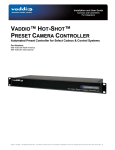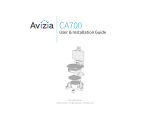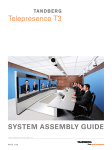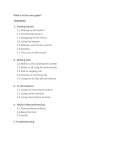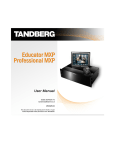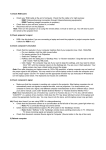Download Movi for Mac User Guide (4.0)
Transcript
Movi 4.0 for Mac User guide D14733.01 September 2010 Table of contents Table of contents Table of contents 2 Getting started 4 Prerequisites Signing in Show video window Making a call Receiving a call Mac requirements Multimedia device requirements Microphone Camera 4 4 4 4 4 5 5 5 5 Preferences 6 General Network Notifications and ringtone Devices 6 6 6 6 Contacts 8 Adding a contact Deleting a contact 8 8 Recent calls 9 Call information Deleting call information 9 9 Presence status 10 Status messages Setting your status 10 10 Closing Movi 11 Closing and reopening the control window Signing out Exiting Movi 11 11 11 The pop-up toolbar 12 Selfview and camera control Controlling your camera Using the keypad (DTMF) When to use the keypad How to use the keypad Using the keypad during conferences Presentation sharing How to share What to share 12 12 13 13 13 13 13 13 14 The info bar 15 Far-end camera control (FECC) How to control the far-end camera Limitations 15 15 16 Joining calls to a conference 17 How to toggle between calls on hold 17 Movi User Guide Page 2 of 19 Table of contents How to join participants to a conference How to end calls on hold 17 17 Troubleshooting 18 Audio issues Further troubleshooting Conference information 18 18 18 Disclaimers and notices 19 Movi User Guide Page 3 of 19 Getting started Getting started Prerequisites The Movi software client is usually made available to you by your company’s IT administrator. A web camera, a microphone, and loudspeakers or a headset must be connected to your computer for Movi to work correctly. (See Multimedia device requirements.) Signing in Your IT administrator can automate your sign-in process, and you may not even notice the sign-in screen. If enabled by your IT administrator, sign-in will be automatic and you may not even notice the sign-in screen. Otherwise, your IT administrator will supply you with a username and password. Note: Automatic sign-in is not available to users of Mac OS X 10.5. 1. Start by entering your username and password in the sign-in form. 2. Movi will sign you in automatically from now on, unless you de-select this in the Preferences dialog. 3. Click Sign in or press Enter . Show video window After you have signed in, Movi displays its control window. If you want to open your video window before a call to check your camera or your hair, click the Show video button on the upper right corner of your Movi control window. You can click the Show video button of your screens. during a call to bring your video window to the top You can also show video by openingMain menu > View > Show video (Command-2). Making a call 1. In the search field, start typing the name of the person to call. 2. Click the name on the list or use your arrow keys to scroll down. 3. Double-click the name, click or press Enter . A video window will now appear on screen. There are three more ways to initiate a new call: a. Click My contacts and select a name from your list. (See Contacts.) b. Click Recent calls and select a name from that list (See Recent calls) c. Enter a video address (SIP URI) for a person or an endpoint directly. Receiving a call When someone calls you on Movi, this dialog will appear: Movi User Guide Page 4 of 19 Getting started Answer or reject the call by clicking the buttons, or close the dialog using the X to ignore the call without this being visible to the caller. Mac requirements Processor All Intel processors. For business-quality HD video, TANDBERG recommends using the TANDBERG PrecisionHD™ USB camera and a 2 GHz Core 2 Duo processor or better. Operating system Mac OS X 10.6 or later is recommended. Movi Make sure to have the latest security updates installed. Connection IP network connection (broadband, LAN, wireless). At least 24 kbps is required for an audio connection. For a video connection, the recommended minimum is 128 kbps. Multimedia device requirements Microphone All microphones work well with Movi. Note that some cameras have built-in microphones. Camera Movi works with most common web cameras. See the TANDBERG Knowledge Base for updated information on Movi and cameras. Movi User Guide Page 5 of 19 Preferences Preferences Movi comes with predefined settings that should work out of the box for most users. From the main menu select Movi > Preferences. Remember to store changes to settings by clicking OK when you are done. General By default Movi starts up at login. Clear the Start TANDBERG Movi automatically at login check box to change this setting. Network If you experience low video quality, for example jitter, lowering the bandwidth can be helpful. If you know that more bandwidth than the default setting is available, you may increase the bandwidth setting for better video quality. Note: Your IT administrator may limit the bandwidth options available to you. Notifications and ringtone You can decide when and how Movi shall notify you when calls come through. To change the ringtone, follow these steps: 1. Use the drop-down menu and select one of the alternatives. 2. Listen to the tone by clicking the Play button. Note that you must stop one ring tone before you can try another. You may also want to tweak the following settings: Do not play notification when I am busy You will see the pop up dialog when you have set your status to Busy, but no ring tone will be played. This setting is enabled by default. Do not play notification when I am in a call You will see the pop up dialog when you are already in a call, but no ring tone will be played. This setting is disabled by default. Devices You may want to use different audio and video devices than those Movi has picked by default. For example, your camera and your Mac may both have built-in microphones. The drop-down lists let you choose from all devices detected on your system: l l Loudspeakers and/or headphones (audio output) Microphones (audio input) Movi User Guide Page 6 of 19 Preferences l Cameras (video input) Movi User Guide Page 7 of 19 Contacts Contacts The My contacts list contains endpoints and Movi users whose video addresses you have stored for quick retrieval and reuse. Note: The My contacts list, the Recent calls list and your password are stored per user. If there are other user accounts on your computer, they will not have access to your list. Adding a contact There are three ways of adding a new contact to the My contacts list. To get started: Use the search field or the Recent calls list to locate a person or endpoint. l l l Either right-click to open the context menu. Select Add to My Contacts.... or select the list entry you want using the mouse or arrow keys. From the main menu, select Contacts > Add to My Contacts.... or select the list entry you want using the mouse or arrow keys. Open the Action pop-up menu in the lower left corner of the control window. Select Add to My Contacts.... You can also add a video address as a contact directly: 1. Click My contacts. 2. Click the + button in the lower left corner or right-click anywhere in the My Contacts list and select New Contact... or in the main menu, select Contacts > New Contact.... 3. Enter the Display name you want to use for your contact. 4. Enter the Number or adress for your contact. 5. Click Add or press Enter . Deleting a contact There are four alternative ways to delete a contact. Click My contacts. l l l l Select the contact you want to delete and press the Delete key on your key board. Click Delete in the pop-up dialog. Either right-click to open the context menu. Select Delete. Click Delete again. Select the list entry you want using the mouse or arrow keys. From the main menu, select Contacts > Delete. Click Delete again. Select the list entry you want to delete using the mouse or arrow keys. Open the Action pop-up menu in the lower left corner of the control window. Select Delete. Click Delete again. Movi User Guide Page 8 of 19 Recent calls Recent calls Call information Recent calls is an overview of your latest outgoing, incoming, and missed calls. You can use the list to redial and to add callers and recipients from the list as contacts. Note: The list of recent calls is stored per user. If there are other user accounts on your computer, they will not have access to your list. Each entry in the recent calls list has an icon indicating status: You made an outgoing call. You answered an incoming call. You missed an incoming call. If you have answered a call from a different Movi installation or endpoint, this will be noted in the list as "Answered elsewhere". Each list entry also contains information on: l l l Date and time of call Call duration (click on each entry to display) Video address of the caller (incoming) or the recipient (outgoing) Deleting call information To clear the Recent calls list: 1. Click Recent calls. 2. Click the link Clear history in the lower right corner. Movi User Guide Page 9 of 19 Presence status Presence status Status messages Your Movi presence status is reflected in search results and contact lists. Online This is an online Movi user. Registered This is a connected endpoint. Away The user has set this status. Busy in call This status is set by Movi or the endpoint when the user is in a call. Busy The user has set this status. Offline This status is set by Movi or the endpoint when the user signs out or exits, but it may also have been set by the user. No status No status information is available for this user, who may be online or offline. Setting your status You can manually change your status by clicking on the Status button next to your name in the Movi control window. The alternatives are: Online Away Busy This status may also turn off the ring tone, depending on your settings. (See Settings.) Appear offline You will remain logged in while appearing offline to others. Note: Your status will change automatically from Online to Busy in call. Movi User Guide Page 10 of 19 Closing Movi Closing Movi Closing and reopening the control window 1. Click the X in the upper left corner, or while the control window is active, click File > Close window (Command-w). 2. Your current status will be displayed on top of the Movi icon. 3. To reopen the Movi control window, click on the Movi icon in the dock. Signing out To sign out from Movi, for example to allow another user to log in: 1. Click the status button in the Movi control window. 2. Select Sign out. Exiting Movi To exit the Movi application completely: In the main menu, select Movi > Quit Movi (Command-q). When you exit Movi, you will also be signed out. Movi User Guide Page 11 of 19 The pop-up toolbar The pop-up toolbar A toolbar with these buttons will appear when you move the mouse pointer over the video window: Icon Controls Description Selfview See yourself on camera. (See Selfview and camera control.) Camera Turn your camera off/on. (See Selfview and camera control.) Microphone Turn your microphone off/on. Speaker volume Click to mute, or drag slider to adjust. Fullscreen Use entire screen for video. Toggled Presentation shar- Share an application window. (See Presentation sharing ing.) End call Hang up. Move the mouse pointer away from the toolbar to make it disappear. Selfview and camera control Selfview is the functionality that lets you see your own camera image. Click on the Selfview button during a call. Selfview will appear to you as a picture-inpicture (PiP) inside the video window. You can: l l Double-click a PiP to focus and enlarge it. Click and drag to move a PiP around inside the window. Controlling your camera on the video pop-up toolbar toggles your camera on and off. Should you switch off the camera during a call, Movi will continue to show the last video frame as a still image to other call participants. If you switch the camera off before the recipient answers your call, there will be no image of you available. You may still turn the camera on during the call. Note: This setting does not affect the cameras of other participants. Movi User Guide Page 12 of 19 The pop-up toolbar Using the keypad (DTMF) When to use the keypad Dual-tone multi-frequency (DTMF) signaling is used for telephone calls in the voice-frequency band. A tone is sent representing each number pressed on the keypad. The tone-based keypad in Movi has several uses, notably: l l l The keypad can be used to create and/or enter passwords for multi-part conferences. Setting up a new conference may in other ways involve equipment that requires DTMF. Voice systems frequently have tone-based menu navigation (such as, "To speak to an operator, please press 1"). How to use the keypad The Keypad button on the video info bar brings up the keypad. You can then enter a number using the mouse. Note: Sending DTMF may fail if the microphone is muted. Using the keypad during conferences The keypad may also be used for changing the layout of your video window and far-end camera control during conferences. Note: This feature relies on the TANDBERG MCU, which may or may not be part of your TANDBERG setup. If in doubt, talk to your IT administrator. When the keypad is active during multi-part conferences, you may: l l l Press 2 or 8 to change the layout. Press 4 or 6 to change which participant appears in the largest pane. Press 1 or 7 to enable far end camera control. 1 and 7 will then zoom in and out if supported 2, 4, 6, and 8 will work as arrows to move the camera of the participant in the largest pane. Presentation sharing How to share During a call, you can share one of your application windows, such as a PowerPoint presentation. You can share an application window by: a. The Presentation button on the video window pop-up toolbar brings up a list of your open application windows. Select any of them to start sharing. To stop, click the same button again, then click Stop sharing presentation. Movi User Guide Page 13 of 19 The pop-up toolbar Your shared window will appear to you as a picture-in-picture (PiP) inside the video window. Double-click a PiP to focus it. Tip: If bandwidth or system resources are limited, turning off your camera during a presentation will improve presentation quality. What to share Participants will see everything that happens in the shared window as it occurs. This feature has many potential uses. Here are a few examples: l l l l Share your word processor and let call participants see your meeting notes as you type. Share pictures from your computer as a slideshow. Draw as you go, share an image editor or other visualization tool. Share your web browser, email inbox, calendar ... Note: Conference participants will not see your mouse cursor in the shared window. Movi User Guide Page 14 of 19 The info bar The info bar An info bar with information and buttons will appear when you are in a call. The information is: l The duration of the conference. The address of the recipient of the call; either one person or the device hosting the conference. l An icon l / indicating if the conference is encrypted or not. The buttons are: Icon Controls Description Far-end camera control Turn your far-end camera control off/on. Numeric keypad Use for tone-based input. (See Using the keypad (DTMF).) Conference info Opens your conference information box. Far-end camera control (FECC) How to control the far-end camera In calls that support far-end camera control, you can adjust the far-end camera to give you a better view of the person(s) you are talking with. To activate the far end camera control, click the FECC button on the info bar in the upper corner of the video window. A control will appear above the toolbar on mouse movement. Movi User Guide Page 15 of 19 The info bar You can also use arrow keys on your keyboard to pan and tilt the far-end camera. To zoom in and out use the + and - keys. Limitations If any of the equipment in the video conference does not support the far-end camera control ability, the button will be disabled (gray). If the functionality is not available at all, the button will not be displayed. Movi User Guide Page 16 of 19 Joining calls to a conference Joining calls to a conference During a call you can have up to four calls on hold, switch between them or join them in a conference. If you make a new call while talking, the current call will be put on hold. A panel to the right shows the calls on hold. The same happens if you accept an incoming call while you are already talking to someone. How to toggle between calls on hold To switch between open calls on hold, mouse over the calls-on-hold indicator on the left hand side of the video. The calls on hold panel opens. Click on the participant. How to join participants to a conference To join calls to a conference, mouse over the indicator. The calls on hold panel opens. Click Join all. How to end calls on hold To end calls, make the call active by clicking it and end the call with the End conference button . Movi User Guide Page 17 of 19 Troubleshooting Troubleshooting Audio issues You cannot hear others If you cannot hear the other participant(s), make sure your loudspeakers or headphones are connected. Then check all volume controls: l l l Your headphones or loudspeakers may have their own volume buttons or switches. The Windows volume settings will override all other volume controls. Look for the loudspeaker icon in your systray to open and/or unmute. Movi has its own volume settings, see page Speaker volume. If this does not solve the problem, it may be that audio is not being sent from the other end. Ask the other participant(s) to perform the microphone check described below. Others cannot hear you If the other call participant(s) cannot hear you, make sure your microphone is properly connected and not muted. Low or distorted sound If call participants are experiencing distorted sound, very low sound, or echos: 1. Check whether any of you have enabled microphone boost, echo cancellation, gain control, noise reduction, digital effects or similar features for your audio devices. 2. Turn all such audio device features off for Movi to work optimally. Further troubleshooting If all local devices are turned on and working and audio and/or video issues remain, the problem could be with the videoconferencing infrastructure setup. Contact your IT administrator for support and further troubleshooting. Conference information Move the cursor over the video window to display the information bar at the top of the window. The Call status info button in the top right corner opens Conference information. Your IT administrator may request such information from you for troubleshooting purposes. Movi User Guide Page 18 of 19 Disclaimers and notices Disclaimers and notices The objective of this documentation is to provide the reader with assistance in using and configuring the product. Product capabilities of TANDBERG and other manufacturers' products change over time and so the required configuration may be different from that indicated here. If you have any suggestions for changes to this document, please feed them back to TANDBERG through your TANDBERG Authorized Service Representative. If you need technical support, please contact your TANDBERG Authorized Service Representative. The specifications for the product and the information in this Guide are subject to change at any time, without notice, by TANDBERG. Every effort has been made to supply complete and accurate information in this Guide; however, TANDBERG assumes no responsibility or liability for any errors or inaccuracies that may appear in this document. TANDBERG® is a registered trademark belonging to Tandberg ASA. Other trademarks used in this document are the property of their respective holders. This Guide may be reproduced in its entirety, including all copyright and intellectual property notices, in limited quantities in connection with the use of this product. Except for the limited exception set forth in the previous sentence, no part of this Guide may be reproduced, stored in a retrieval system, or transmitted, in any form, or by any means, electronically, mechanically, by photocopying, or otherwise, without the prior written permission of TANDBERG. www.tandberg.com © 2010 TANDBERG TANDBERG is now part of Cisco. Movi User Guide Page 19 of 19






















